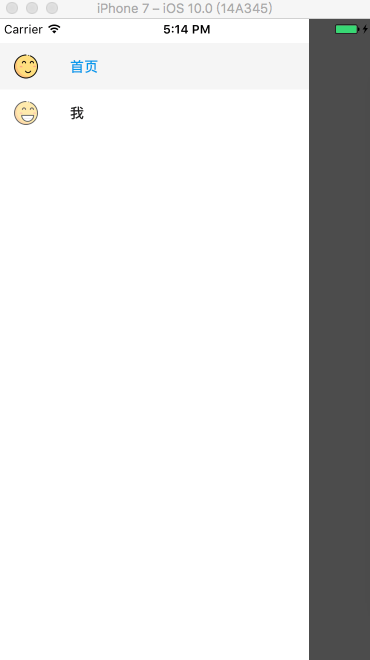另一個大嬸寫的關於抽屜的博文: http://blog.csdn.net/lu1024188315/article/details/73608616 今天參考大灰狼得博客,好好得總結一下navigation得用法。以前總是看官方文檔,但理解得不太透測。 一、開源庫介紹 今年1月份,新開源的React ...
另一個大嬸寫的關於抽屜的博文: http://blog.csdn.net/lu1024188315/article/details/73608616
今天參考大灰狼得博客,好好得總結一下navigation得用法。以前總是看官方文檔,但理解得不太透測。
一、開源庫介紹
今年1月份,新開源的React-natvigation庫備受矚目。在短短不到3個月的時間,github上星數已達4000+。Fb推薦使用庫,並且在React Native當前最新版本0.44中將Navigator刪除。react-navigation據稱有原生般的性能體驗效果。可能會成為未來React Native導航組件的主流軍。本篇內容基於【 ^1.0.0-beta.9 】版本來介紹關於該庫的使用和實戰技巧。可以看到,雖然是beta版本,不過基本穩定,大家可放心在項目中使用。該庫包含三類組件:
(1)StackNavigator:用來跳轉頁面和傳遞參數
(2)TabNavigator:類似底部導航欄,用來在同一屏幕下切換不同界面
(3)DrawerNavigator:側滑菜單導航欄,用於輕鬆設置帶抽屜導航的屏幕
二、react-navigation使用
具體內容大致分為如下:
(1)react-navigation庫屬性介紹
(2)StackNavigator、TabNavigator實現界面間跳轉,Tab切換
(3)StackNavigator界面間跳轉、傳值、取值
(4)DrawerNavigator實現抽屜導航菜單
(5)DrawerNavigator擴展功能
(6)修改源碼,定製UI界面
1、StackNavigator屬性介紹
navigationOptions:配置StackNavigator的一些屬性。 title:標題,如果設置了這個導航欄和標簽欄的title就會變成一樣的,不推薦使用 header:可以設置一些導航的屬性,如果隱藏頂部導航欄只要將這個屬性設置為null headerTitle:設置導航欄標題,推薦 headerBackTitle:設置跳轉頁面左側返回箭頭後面的文字,預設是上一個頁面的標題。可以自定義,也可以設置為null headerTruncatedBackTitle:設置當上個頁面標題不符合返回箭頭後的文字時,預設改成"返回" headerRight:設置導航條右側。可以是按鈕或者其他視圖控制項 headerLeft:設置導航條左側。可以是按鈕或者其他視圖控制項 headerStyle:設置導航條的樣式。背景色,寬高等 headerTitleStyle:設置導航欄文字樣式 headerBackTitleStyle:設置導航欄‘返回’文字樣式 headerTintColor:設置導航欄顏色 headerPressColorAndroid:安卓獨有的設置顏色紋理,需要安卓版本大於5.0 gesturesEnabled:是否支持滑動返回手勢,iOS預設支持,安卓預設關閉 screen:對應界面名稱,需要填入import之後的頁面 mode:定義跳轉風格 card:使用iOS和安卓預設的風格 modal:iOS獨有的使屏幕從底部畫出。類似iOS的present效果 headerMode:返回上級頁面時動畫效果 float:iOS預設的效果 screen:滑動過程中,整個頁面都會返回 none:無動畫 cardStyle:自定義設置跳轉效果 transitionConfig: 自定義設置滑動返回的配置 onTransitionStart:當轉換動畫即將開始時被調用的功能 onTransitionEnd:當轉換動畫完成,將被調用的功能 path:路由中設置的路徑的覆蓋映射配置 initialRouteName:設置預設的頁面組件,必須是上面已註冊的頁面組件 initialRouteParams:初始路由參數註:大家可能對於path不太理解。path屬性適用於其他app或瀏覽器使用url打開本app併進入指定頁面。path屬性用於聲明一個界面路徑,例如:【/pages/Home】。此時我們可以在手機瀏覽器中輸入:app名稱://pages/Home來啟動該App,併進入Home界面。
2、TabNavigator屬性介紹
screen:和導航的功能是一樣的,對應界面名稱,可以在其他頁面通過這個screen傳值和跳轉。 navigationOptions:配置TabNavigator的一些屬性 title:標題,會同時設置導航條和標簽欄的title tabBarVisible:是否隱藏標簽欄。預設不隱藏(true) tabBarIcon:設置標簽欄的圖標。需要給每個都設置 tabBarLabel:設置標簽欄的title。推薦 導航欄配置 tabBarPosition:設置tabbar的位置,iOS預設在底部,安卓預設在頂部。(屬性值:'top','bottom') swipeEnabled:是否允許在標簽之間進行滑動 animationEnabled:是否在更改標簽時顯示動畫 lazy:是否根據需要懶惰呈現標簽,而不是提前,意思是在app打開的時候將底部標簽欄全部載入,預設false,推薦為true trueinitialRouteName: 設置預設的頁面組件 backBehavior:按 back 鍵是否跳轉到第一個Tab(首頁), none 為不跳轉 tabBarOptions:配置標簽欄的一些屬性iOS屬性 activeTintColor:label和icon的前景色 活躍狀態下 activeBackgroundColor:label和icon的背景色 活躍狀態下 inactiveTintColor:label和icon的前景色 不活躍狀態下 inactiveBackgroundColor:label和icon的背景色 不活躍狀態下 showLabel:是否顯示label,預設開啟 style:tabbar的樣式 labelStyle:label的樣式安卓屬性 activeTintColor:label和icon的前景色 活躍狀態下 inactiveTintColor:label和icon的前景色 不活躍狀態下 showIcon:是否顯示圖標,預設關閉 showLabel:是否顯示label,預設開啟 style:tabbar的樣式 labelStyle:label的樣式 upperCaseLabel:是否使標簽大寫,預設為true pressColor:material漣漪效果的顏色(安卓版本需要大於5.0) pressOpacity:按壓標簽的透明度變化(安卓版本需要小於5.0) scrollEnabled:是否啟用可滾動選項卡 tabStyle:tab的樣式 indicatorStyle:標簽指示器的樣式對象(選項卡底部的行)。安卓底部會多出一條線,可以將height設置為0來暫時解決這個問題 labelStyle:label的樣式 iconStyle:圖標樣式3、DrawerNavigator屬性介紹
DrawerNavigatorConfig drawerWidth - 抽屜的寬度 drawerPosition - 選項是左或右。 預設為左側位置 contentComponent - 用於呈現抽屜內容的組件,例如導航項。 接收抽屜的導航。 預設為DrawerItems contentOptions - 配置抽屜內容 initialRouteName - 初始路由的routeName order - 定義抽屜項目順序的routeNames數組。 路徑 - 提供routeName到路徑配置的映射,它覆蓋routeConfigs中設置的路徑。 backBehavior - 後退按鈕是否會切換到初始路由? 如果是,設置為initialRoute,否則為none。 預設為initialRoute行為 DrawerItems的contentOptions屬性 activeTintColor - 活動標簽的標簽和圖標顏色 activeBackgroundColor - 活動標簽的背景顏色 inactiveTintColor - 非活動標簽的標簽和圖標顏色 inactiveBackgroundColor - 非活動標簽的背景顏色 內容部分的樣式樣式對象 labelStyle - 當您的標簽是字元串時,要覆蓋內容部分中的文本樣式的樣式對象從上述中大致瞭解了react-navigation三種組件的一些基本屬性,所以到我們甩起袖子擼代碼見證下奇跡了。
4、使用StackNavigator + TabNavigator實現Tab界面切換、界面間導航
API定義:StackNavigator(RouteConfigs, StackNavigatorConfig)、TabNavigator(RouteConfigs, TabNavigatorConfig)
(1)集成 react-navigation:在終端執行 【 npm install react-navigation --save 】
(2)界面中導入必要組件:import {StackNavigator,TabNavigator,TabBarBottom} from 'react-navigation'; import HomeScreen from './pages/HomePage'; import MineScreen from './pages/MinePage';(3)定義TabNavigator:
const Tab = TabNavigator( { Home:{ screen:HomeScreen, navigationOptions:({navigation}) => ({ tabBarLabel:'首頁', tabBarIcon:({focused,tintColor}) => ( <TabBarItem tintColor={tintColor} focused={focused} normalImage={require('./imgs/[email protected]')} selectedImage={require('./imgs/[email protected]')} /> ) }), }, Mine:{ screen:MineScreen, navigationOptions:({navigation}) => ({ tabBarLabel:'我', tabBarIcon:({focused,tintColor}) => ( <TabBarItem tintColor={tintColor} focused={focused} normalImage={require('./imgs/[email protected]')} selectedImage={require('./imgs/[email protected]')} /> ) }), }, }, { tabBarComponent:TabBarBottom, tabBarPosition:'bottom', swipeEnabled:false, animationEnabled:false, lazy:true, tabBarOptions:{ activeTintColor:'#06c1ae', inactiveTintColor:'#979797', style:{backgroundColor:'#ffffff',}, labelStyle: { fontSize: 20, // 文字大小 }, } } );
TabBarItem為封裝的組件:
import React,{Component} from 'react'; import {Image} from 'react-native'; export default class TabBarItem extends Component { render() { return( <Image source={ this.props.focused ? this.props.selectedImage : this.props.normalImage } style={ { tintColor:this.props.tintColor,width:25,height:25 } } /> ) } }
可以看到,我們定義了一個名稱為【Tab】的TabNavigator的導航組件。在組件中,分為兩層參數:
(1)第一層參數定義了要切換的界面,即【首頁】、【我】兩個界面組件,通過screen屬性指定。並且通過navigationOptions屬性設置相關屬性參數。
(2)設置導航欄的屬性參數。
TabNavigator定義好之後,需要用StackNavigator,顧名思義,StackNavigator就是以棧的方式來存放整個界面的,而TabNavigator是作為一個界面內不同子界面之間切換。所以還需要我們定義StackNavigator:const Navigator = StackNavigator( { Tab:{screen:Tab}, Product:{screen:ProductScreen} }, { navigationOptions:{ headerBackTitle:null, headerTintColor:'#333333', showIcon:true, swipeEnabled:false, animationEnabled:false, }, mode:'card', });看起來和TabNavigator很相似,同樣是指定了兩個參數:
(1)指定要跳轉的界面組件。同樣是screen屬性標識界面組件,不多贅述。
(2)定義跳轉屬性參數,即頂部導航欄的一些參數設置和跳轉方式。
可以看到,我們將Tab作為一個界面設置到了StackNavigator。這樣就可以實現Tab導航和界面間跳轉的效果了。
最後就是在render中引用StackNavigator:
export default class Demo extends Component { render() { return ( <Navigator /> ); } }
StackNavigator還提供了onNavigationStateChange回調方法,用來監聽導航狀態的改變。具體不再贅述。實現了界面跳轉和切換,那麼就該來增加下界面之間的感情了,來看看如何實現界面之間的傳值和取值。
5、界面間跳轉、傳值、取值
在界面組件註入到StackNavigator中時,界面組件就被賦予了navigation屬性,即在界面組件中可以通過【this.props.navigation】獲取併進行一些操作。
navigation屬性中提供了很多的函數簡化界面間操作,簡單列舉幾點:
(1)通過navigate函數實現界面之間跳轉:
this.props.navigation.navigate('Mine');
參數為我們在StackNavigator註冊界面組件時的名稱。同樣也可以從當前頁面返回到上一頁:
// 返回上一頁 this.props.navigation.goBack();
(2)跳轉時傳值:
this.props.navigation.navigate('Mine',{info:'傳值過去'});
第一個參數同樣為要跳轉的界面組件名稱,第二個參數為要傳遞的參數,info可以理解為key,後面即傳遞的參數。
(3)獲取值:
{this.props.navigation.state.params.info}
通過state.params來獲取傳來的參數,後面為key值。此處為info。
以上實現完成,我們就可以愉快的玩耍啦~~ 什麼?忽然發現在Android上的效果和IOS效果不一樣。老闆要界面一致哇~ 怎麼辦?那就需要我們進行簡單的適配了。
三、DrawerNavigator實現抽屜導航
1、導航實現
API定義:DrawerNavigator(RouteConfigs,DrawerNavigatorConfig)
(1)界面中定義DrawerNavigator:import {StackNavigator,TabNavigator,DrawerNavigator} from 'react-navigation'; import HomeScreen from './pages/HomePage'; import MineScreen from './pages/MinePage'; export default class Demo extends Component { render() { return ( <Navigator /> ); } } const Navigator = DrawerNavigator({ Home:{screen:HomeScreen}, Mine:{screen:MineScreen}, }); const styles = StyleSheet.create({ container: { flex: 1, }, }); AppRegistry.registerComponent('Demo', () => Demo);
定義方式和StackNavigator基本類似,不再贅述。
(2)HomeScreen界面和MineScreen界面:
export default class HomePage extends Component { static navigationOptions = { drawerLabel: '首頁', drawerIcon:({tintColor}) => ( <Image source={require('./../imgs/ic_happy.png')} style={[styles.icon, {tintColor: tintColor}]}/> ), }; render() { return( <View style={{flex:1}}> <Text onPress={this._skip.bind(this)}>點擊跳轉</Text> </View> ); } _skip() { this.props.navigation.navigate("Mine"); } } export default class MinePage extends Component { static navigationOptions = { drawerLabel:'我', drawerIcon: ({ tintColor }) => ( <Image source={require('./../imgs/ic_h.png')} style={[styles.icon, {tintColor: tintColor}]} /> ), }; render() { return( <View style={{flex:1}}> <Text onPress={this._skip.bind(this)}>返回上一界面</Text> </View> ); } /** * 跳轉 */ _skip() { this.props.navigation.goBack(); } }
代碼很簡單,實現了界面之間的跳轉。
2、擴展功能
(1)預設DrawerView不可滾動。要實現可滾動視圖,必須使用contentComponent自定義容器,如下所示:
{ drawerWidth:200, 抽屜位置:“對” contentComponent:props => <ScrollView> <DrawerItems {... props} /> </ ScrollView> }
(2)可以覆蓋導航使用的預設組件,使用DrawerItems自定義導航組件:
import {DrawerItems} from 'react-navigation'; const CustomDrawerContentComponent = (props) => ( <View style = {style.container}> <DrawerItems {... props} /> </View> );
(3)嵌套抽屜導航
如果您嵌套DrawerNavigation,抽屜將顯示在父導航下方。
四、react-navigation源碼定製
(1)適配頂部導航欄標題:
測試中發現,在iphone上標題欄的標題為居中狀態,而在Android上則是居左對齊。所以需要我們修改源碼,進行適配。
【node_modules -- react-navigation -- src -- views -- Header.js】的326行代碼處,修改為如下:
title: { bottom: 0, left: TITLE_OFFSET, right: TITLE_OFFSET, top: 0, position: 'absolute', alignItems: 'center', }(2)去除返回鍵文字顯示:
【node_modules -- react-navigation -- src -- views -- HeaderBackButton.js】的91行代碼處,修改為如下即可。
{Platform.OS === 'ios' && title && <Text onLayout={this._onTextLayout} style={[styles.title, { color: tintColor }]} numberOfLines={1} > {backButtonTitle} </Text>}
將上述代碼刪除即可。
(3)設置標題欄的按鈕單擊事件:
因為在界面組件中設置標題參數時,需要將navigationOptions定義成static。所以我們不能直接通過this.xxx.bind(this)來調用自定義函數,怎麼辦呢?可以通過如何方式解決:
class demo extends Component { static navigationOptions =({navigation})=>({ right:( <Button onPress={state.params.clickParams}/>) }) _btnClick=()=> { alert('單擊') }; componentWillMount() { this.props.navigation.setParams({clickParams:this._btnClick}) } }
(4)動態設置標題欄顯示和隱藏
根據(3)中的思想,我們可以利用setParams來動態修改狀態欄的顯示和隱藏:
class demo extends Component { static navigationOptions = ({navigation}) =>({ visible: state.params.headerState , }); render(){ return( <Button title="Hide Header" onPress={() => this.props.navigation.setParams({ headerState : 'none' })} />) } }
五、效果圖
抽屜導航:
這篇文章真心值得收藏!+點贊+分享!!!



